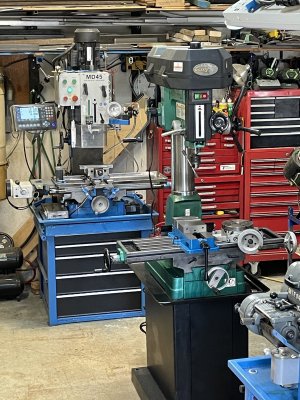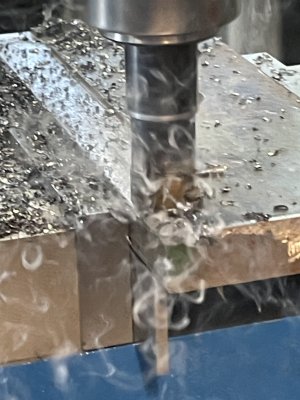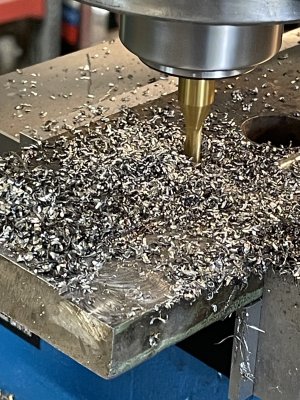These are both large bench top mills, but a rectangle column mill compared to a round column mill seems like an unfair/off balance discussion. Not to mention that the RF45 weighs 300 pounds more than the PDM30.
True enough, but it just so happens (that for 2 weeks) I have had both side by side in my small shop.
Just to clarify: my RF45 clone is a 3 year old MD45 from Modern Tool and my PDM30 is actually a 22 year old Grizzle G1006 Mill/Drill which is now sold as a Grizzle G0705. Here is the G1006 about to go into the trailer, thanks @trlvn and @Canadium for all your help.

Here they are set up in my very crowded shop space.

Configurations:
They both have nearly the same size table and x travel. The MD45 has almost an 1” more y and 3” more z travel. They both have 5” of quill stroke. They are both sold as 2 Hp machines but the MD45 motor is [email protected] while the G1006 has a much physically larger motor and is either 110V@23amps or [email protected]. Mine came factory wired as 110V. The MD45 has both motor and head cantilever on the front, while the G1006 has the motor at the back which sort of balances the weight of the head at the front. The MD45 motor is mounted on top whereas the G1006 motor is mounted underneath and more out of the way. Changing belts on the G1006 requires access to the right side and could be an issue. The MD45 is a 6 speed gear head, but the G1006 is a 12 speed belt drive. If my MD45 had 12 speeds I would not be considering a VFD upgrade. Also the belt drive is quiet. It is much easier and quicker to charge bells than I had imagined. Changing gears on the MD45 is super fast and simple- but it’s not that big of a deal to do a belt change on the G1006. I get that now. The HD base of the G1006 and large column diameter are very solid for the size of this machine. I was very impressed with its rigidity.
I did some aggressive EM cuts today on a piece of mild steel. WOW, the G1006 performed surprisingly well on just 110V. Also smooth and vibration free. It pretty much matched what I am use to with the MD45.


 I joined the forum (3years ago) to help me figure out what mill to buy. New or used? I got great advice - thanks to all that helped me on that journey. I had some bad experiences with kijiji (wild goose chases). So decided a new machine was expensive but a better choice for this newbie. I was about to get a Precision Matthews mill but then found Modern Tool. I visited their shop/show room. They had a PDM30 sized round column mill (their clone of a PDM30) in their shop. Someone had ordered it and then changed their mind (it was close to a $1000 less than a MD45). Great price and included factory installed flood coolant system + x power feed. But i said no thanks because of the round column. If i had to do it over, i would have / should have taken that deal. Hind sight is 20/20.
I joined the forum (3years ago) to help me figure out what mill to buy. New or used? I got great advice - thanks to all that helped me on that journey. I had some bad experiences with kijiji (wild goose chases). So decided a new machine was expensive but a better choice for this newbie. I was about to get a Precision Matthews mill but then found Modern Tool. I visited their shop/show room. They had a PDM30 sized round column mill (their clone of a PDM30) in their shop. Someone had ordered it and then changed their mind (it was close to a $1000 less than a MD45). Great price and included factory installed flood coolant system + x power feed. But i said no thanks because of the round column. If i had to do it over, i would have / should have taken that deal. Hind sight is 20/20.
CW
PS1: The Grizzle G1006 is very similar to King Canada’s PDM-30 except the Grizzly weighs 100 pounds more than the PDM-30. The Grizzle is made in Taiwan vs China for the King. This Grizzle has the optional conversion kit and is pre-wired for 110V but can easily be converted to 220V.
PS2: Here is a video from “that lazy machinists” that explains how to minimize the need to use the Z travel on a round column mill. He is a bit too long winded (like a lot of YouTube’ers) but has some good tips.
True enough, but it just so happens (that for 2 weeks) I have had both side by side in my small shop.
Just to clarify: my RF45 clone is a 3 year old MD45 from Modern Tool and my PDM30 is actually a 22 year old Grizzle G1006 Mill/Drill which is now sold as a Grizzle G0705. Here is the G1006 about to go into the trailer, thanks @trlvn and @Canadium for all your help.

Here they are set up in my very crowded shop space.

Configurations:
They both have nearly the same size table and x travel. The MD45 has almost an 1” more y and 3” more z travel. They both have 5” of quill stroke. They are both sold as 2 Hp machines but the MD45 motor is [email protected] while the G1006 has a much physically larger motor and is either 110V@23amps or [email protected]. Mine came factory wired as 110V. The MD45 has both motor and head cantilever on the front, while the G1006 has the motor at the back which sort of balances the weight of the head at the front. The MD45 motor is mounted on top whereas the G1006 motor is mounted underneath and more out of the way. Changing belts on the G1006 requires access to the right side and could be an issue. The MD45 is a 6 speed gear head, but the G1006 is a 12 speed belt drive. If my MD45 had 12 speeds I would not be considering a VFD upgrade. Also the belt drive is quiet. It is much easier and quicker to charge bells than I had imagined. Changing gears on the MD45 is super fast and simple- but it’s not that big of a deal to do a belt change on the G1006. I get that now. The HD base of the G1006 and large column diameter are very solid for the size of this machine. I was very impressed with its rigidity.
I did some aggressive EM cuts today on a piece of mild steel. WOW, the G1006 performed surprisingly well on just 110V. Also smooth and vibration free. It pretty much matched what I am use to with the MD45.


 I joined the forum (3years ago) to help me figure out what mill to buy. New or used? I got great advice - thanks to all that helped me on that journey. I had some bad experiences with kijiji (wild goose chases). So decided a new machine was expensive but a better choice for this newbie. I was about to get a Precision Matthews mill but then found Modern Tool. I visited their shop/show room. They had a PDM30 sized round column mill (their clone of a PDM30) in their shop. Someone had ordered it and then changed their mind (it was close to a $1000 less than a MD45). Great price and included factory installed flood coolant system + x power feed. But i said no thanks because of the round column. If i had to do it over, i would have / should have taken that deal. Hind sight is 20/20.
I joined the forum (3years ago) to help me figure out what mill to buy. New or used? I got great advice - thanks to all that helped me on that journey. I had some bad experiences with kijiji (wild goose chases). So decided a new machine was expensive but a better choice for this newbie. I was about to get a Precision Matthews mill but then found Modern Tool. I visited their shop/show room. They had a PDM30 sized round column mill (their clone of a PDM30) in their shop. Someone had ordered it and then changed their mind (it was close to a $1000 less than a MD45). Great price and included factory installed flood coolant system + x power feed. But i said no thanks because of the round column. If i had to do it over, i would have / should have taken that deal. Hind sight is 20/20.CW
PS1: The Grizzle G1006 is very similar to King Canada’s PDM-30 except the Grizzly weighs 100 pounds more than the PDM-30. The Grizzle is made in Taiwan vs China for the King. This Grizzle has the optional conversion kit and is pre-wired for 110V but can easily be converted to 220V.
PS2: Here is a video from “that lazy machinists” that explains how to minimize the need to use the Z travel on a round column mill. He is a bit too long winded (like a lot of YouTube’ers) but has some good tips.
Last edited:
